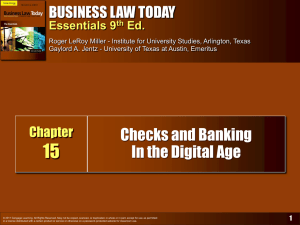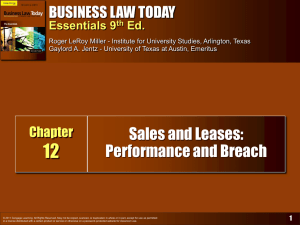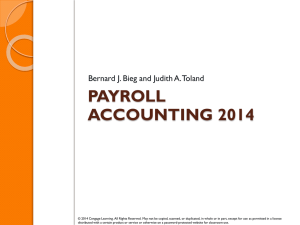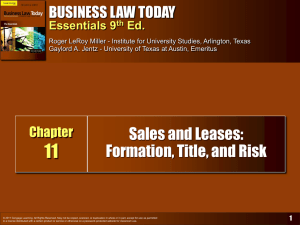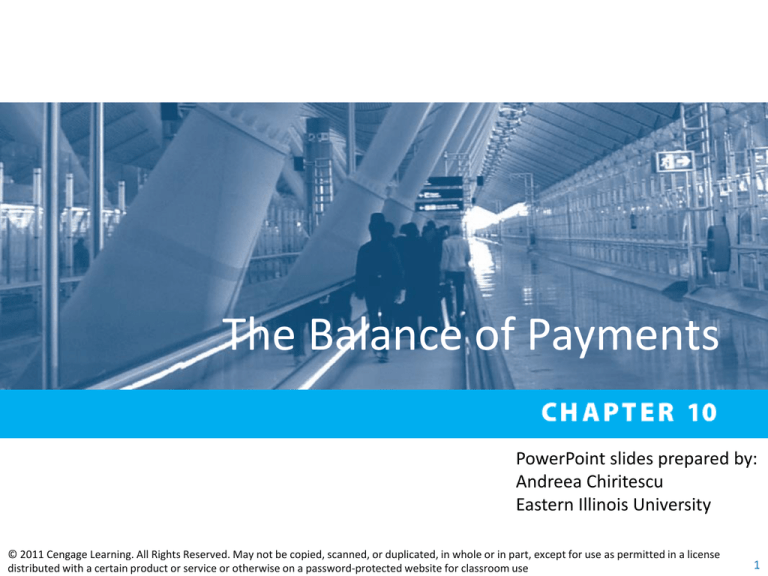
The Balance of Payments
PowerPoint slides prepared by:
Andreea Chiritescu
Eastern Illinois University
© 2011 Cengage Learning. All Rights Reserved. May not be copied, scanned, or duplicated, in whole or in part, except for use as permitted in a license
distributed with a certain product or service or otherwise on a password‐protected website for classroom use
1
Double-Entry Accounting
• Balance of payments
• Record of the economic transactions
• Between the residents of one country and the
rest of the world
• Double-entry accounting system
• International transaction
• Exchange of goods, services, or assets
• Between residents of one country and those of
another
© 2011 Cengage Learning. All Rights Reserved. May not be copied, scanned, or duplicated, in whole or in part, except for use as permitted in a license
distributed with a certain product or service or otherwise on a password‐protected website for classroom use
2
Double-Entry Accounting
• Residents
• Businesses, individuals, and government
agencies
• That make the country in question their legal
domicile
• Credit transaction (+)
• Receipt of a payment from foreigners
• Debit transaction (-)
• Payment to foreigners
© 2011 Cengage Learning. All Rights Reserved. May not be copied, scanned, or duplicated, in whole or in part, except for use as permitted in a license
distributed with a certain product or service or otherwise on a password‐protected website for classroom use
3
Double-Entry Accounting
• U.S. credit transaction (+)
•
•
•
•
•
•
Merchandise exports
Transportation and travel receipts
Income received from investments abroad
Gifts received from foreign residents
Aid received from foreign governments
Investments in the United States by overseas
residents
© 2011 Cengage Learning. All Rights Reserved. May not be copied, scanned, or duplicated, in whole or in part, except for use as permitted in a license
distributed with a certain product or service or otherwise on a password‐protected website for classroom use
4
Double-Entry Accounting
• U.S. debit transaction (-)
•
•
•
•
•
•
Merchandise imports
Transportation and travel expenditures
Income paid on the investments of foreigners
Gifts to foreign residents
Aid given by the U.S. government
Overseas investment by U.S. residents
© 2011 Cengage Learning. All Rights Reserved. May not be copied, scanned, or duplicated, in whole or in part, except for use as permitted in a license
distributed with a certain product or service or otherwise on a password‐protected website for classroom use
5
Double-Entry Accounting
• Total balance-of-payments account
• Must always be in balance
• Surplus
• Balance on a subaccount (subaccounts) is
positive
• Deficit
• Balance on a subaccount (subaccounts) is
negative
© 2011 Cengage Learning. All Rights Reserved. May not be copied, scanned, or duplicated, in whole or in part, except for use as permitted in a license
distributed with a certain product or service or otherwise on a password‐protected website for classroom use
6
GLOBALIZATION
International payments process
• In theory
• Importers in a country pay the exporters in that
same country in the national currency
• In reality
• Importers and exporters in a given country do
not deal directly with one another
• To facilitate payments, banks carry out these
transactions
© 2011 Cengage Learning. All Rights Reserved. May not be copied, scanned, or duplicated, in whole or in part, except for use as permitted in a license
distributed with a certain product or service or otherwise on a password‐protected website for classroom use
7
FIGURE 10.1 International payments process
© 2011 Cengage Learning. All Rights Reserved. May not be copied, scanned, or duplicated, in whole or in part, except for use as permitted in a license
distributed with a certain product or service or otherwise on a password‐protected website for classroom use
8
Balance-of-Payments Structure
• Current account of the balance of payments
• Monetary value of international flows:
• Transactions in goods, services, income flows, and
unilateral transfers
• Merchandise trade
• All of the goods the United States exports or
imports
• Agricultural products, machinery, autos, petroleum,
electronics, textiles
© 2011 Cengage Learning. All Rights Reserved. May not be copied, scanned, or duplicated, in whole or in part, except for use as permitted in a license
distributed with a certain product or service or otherwise on a password‐protected website for classroom use
9
Balance-of-Payments Structure
• Merchandise trade balance
• Credit (+): the dollar value of merchandise
exports
• Debit (-): the dollar value of merchandise
imports
• If negative: merchandise trade deficit
• If positive: merchandise trade surplus
© 2011 Cengage Learning. All Rights Reserved. May not be copied, scanned, or duplicated, in whole or in part, except for use as permitted in a license
distributed with a certain product or service or otherwise on a password‐protected website for classroom use
10
Balance-of-Payments Structure
• Services
• All the services the U.S. exports or imports
• Goods and services balance
• Services and merchandise trade account
• If positive:
• Surplus of goods and services transactions
• If negative:
• Deficit of goods and services transactions
© 2011 Cengage Learning. All Rights Reserved. May not be copied, scanned, or duplicated, in whole or in part, except for use as permitted in a license
distributed with a certain product or service or otherwise on a password‐protected website for classroom use
11
Balance-of-Payments Structure
• Goods and services balance
• Net export of goods and services
• Positive:
• Excess exports over imports
• Add to GDP
• Negative:
• Excess imports over exports
• Subtracted from GDP
© 2011 Cengage Learning. All Rights Reserved. May not be copied, scanned, or duplicated, in whole or in part, except for use as permitted in a license
distributed with a certain product or service or otherwise on a password‐protected website for classroom use
12
Balance-of-Payments Structure
• Income receipts and payments
• Net earnings (dividends and interest) on U.S.
investments abroad
• Earnings on U.S. investments abroad
• Minus payments on foreign assets in the U.S.
• Compensation to employees
© 2011 Cengage Learning. All Rights Reserved. May not be copied, scanned, or duplicated, in whole or in part, except for use as permitted in a license
distributed with a certain product or service or otherwise on a password‐protected website for classroom use
13
Balance-of-Payments Structure
• Unilateral transfers
• Transfers of goods and services (gifts in kind) or
financial assets (money gifts)
• Between the U.S. and the rest of the world
• Private transfer payments
• Governmental transfers
• Current account balance
• Balance on goods and services
• Investment income
• Unilateral transfers
© 2011 Cengage Learning. All Rights Reserved. May not be copied, scanned, or duplicated, in whole or in part, except for use as permitted in a license
distributed with a certain product or service or otherwise on a password‐protected website for classroom use
14
Balance-of-Payments Structure
• Capital and financial account
• Capital and financial transactions in the
balance of payments
• All international purchases or sales of assets
• Private-sector and official transactions
• Private-sector financial transactions
• Direct investment
• Securities
• Bank claims and liabilities
© 2011 Cengage Learning. All Rights Reserved. May not be copied, scanned, or duplicated, in whole or in part, except for use as permitted in a license
distributed with a certain product or service or otherwise on a password‐protected website for classroom use
15
Balance-of-Payments Structure
• Balance-of-payments statement
• Credit (+): capital and financial inflows
• Leads to the home country’s receiving payments
from foreigners
• Export of goods and services
• Debit (-): capital and financial outflows
• Leads to foreigners’ receiving payments
• Import of goods and services
© 2011 Cengage Learning. All Rights Reserved. May not be copied, scanned, or duplicated, in whole or in part, except for use as permitted in a license
distributed with a certain product or service or otherwise on a password‐protected website for classroom use
16
Balance-of-Payments Structure
• Official settlements transactions
• Movement of financial assets among official
holders
• Official reserve assets
• Liabilities to foreign official agencies
• Statistical discrepancy
• Errors and omissions
• Information – some is collected, some is
estimated
© 2011 Cengage Learning. All Rights Reserved. May not be copied, scanned, or duplicated, in whole or in part, except for use as permitted in a license
distributed with a certain product or service or otherwise on a password‐protected website for classroom use
17
TABLE 10.1 U.S. reserve assets, 2008*
© 2011 Cengage Learning. All Rights Reserved. May not be copied, scanned, or duplicated, in whole or in part, except for use as permitted in a license
distributed with a certain product or service or otherwise on a password‐protected website for classroom use
18
TABLE 10.2 Selected U.S. liabilities to foreign official
institutions, 2008*
© 2011 Cengage Learning. All Rights Reserved. May not be copied, scanned, or duplicated, in whole or in part, except for use as permitted in a license
distributed with a certain product or service or otherwise on a password‐protected website for classroom use
19
U.S. Balance of Payments
• 2008, U.S. - merchandise trade deficit
• Exports < Imports
• Not popular - adverse consequences on
• Terms of trade
• Employment levels
• Stability of the international money markets
© 2011 Cengage Learning. All Rights Reserved. May not be copied, scanned, or duplicated, in whole or in part, except for use as permitted in a license
distributed with a certain product or service or otherwise on a password‐protected website for classroom use
20
TABLE 10.3 U.S. balance of payments, 2008 (billions of dollars)*
© 2011 Cengage Learning. All Rights Reserved. May not be copied, scanned, or duplicated, in whole or in part, except for use as permitted in a license
distributed with a certain product or service or otherwise on a password‐protected website for classroom use
21
U.S. Balance of Payments
• 2008, U.S. – goods and services balance
• Surplus on service transactions
• Merchandise trade deficit
• Overall: deficit
• 2008, U.S. – current account deficit
• Excess of imports over exports
• Goods, services, income flows, and unilateral
transfers
© 2011 Cengage Learning. All Rights Reserved. May not be copied, scanned, or duplicated, in whole or in part, except for use as permitted in a license
distributed with a certain product or service or otherwise on a password‐protected website for classroom use
22
TABLE 10.4 U.S. balance of payments, 1980–2008 (billions of
dollars)
© 2011 Cengage Learning. All Rights Reserved. May not be copied, scanned, or duplicated, in whole or in part, except for use as permitted in a license
distributed with a certain product or service or otherwise on a password‐protected website for classroom use
23
TRADE
CONFLICTS
The paradox of capital flows from
developing to industrial countries
• Sources of the net capital flow out of the
developing economies
• China, Japan, Russia
• OPEC
• Divergent patterns of growth and investment
• Structural differences
• Between developing and industrial economies
© 2011 Cengage Learning. All Rights Reserved. May not be copied, scanned, or duplicated, in whole or in part, except for use as permitted in a license
distributed with a certain product or service or otherwise on a password‐protected website for classroom use
24
TRADE
CONFLICTS
The paradox of capital flows from
developing to industrial countries
• Current account deficits in the industrial
countries
• Increases in both public and private
consumption
• Declines in national savings rates
© 2011 Cengage Learning. All Rights Reserved. May not be copied, scanned, or duplicated, in whole or in part, except for use as permitted in a license
distributed with a certain product or service or otherwise on a password‐protected website for classroom use
25
What Does a Current Account Deficit
(Surplus) Mean?
• Balance of payments
• Double-entry accounting system
• Total debits = Total credits
• If the current account registers a deficit
• The capital and financial account must register a
surplus
• If the current account registers a surplus
• The capital and financial account must register a
deficit
© 2011 Cengage Learning. All Rights Reserved. May not be copied, scanned, or duplicated, in whole or in part, except for use as permitted in a license
distributed with a certain product or service or otherwise on a password‐protected website for classroom use
26
What Does a Current Account Deficit
(Surplus) Mean?
• Current account balance
• Net foreign investment in national income
accounting
• Current account surplus
• Excess of exports over imports
• Goods, services, investment income, unilateral transfers
•
•
•
•
Net receipt of financial claims
Improved net foreign investment position
Capital outflows
Net supplier of funds (lender)
© 2011 Cengage Learning. All Rights Reserved. May not be copied, scanned, or duplicated, in whole or in part, except for use as permitted in a license
distributed with a certain product or service or otherwise on a password‐protected website for classroom use
27
What Does a Current Account Deficit
(Surplus) Mean?
• Current account deficit
• Excess of imports over exports
• Goods, services, investment income, unilateral transfers
• Increase in net foreign claims upon the home
nation
• Foreign capital inflows
• Net demander of funds from abroad
• Worsening of the home nation’s net foreign
investment position
© 2011 Cengage Learning. All Rights Reserved. May not be copied, scanned, or duplicated, in whole or in part, except for use as permitted in a license
distributed with a certain product or service or otherwise on a password‐protected website for classroom use
28
What Does a Current Account Deficit
(Surplus) Mean?
• Net borrowing of an economy
• Net borrowing by government
• Budget deficit: excess of outlays (G) over taxes (T)
• Private-sector net borrowing
• Excess of private investment (I) over private
saving (S)
© 2011 Cengage Learning. All Rights Reserved. May not be copied, scanned, or duplicated, in whole or in part, except for use as permitted in a license
distributed with a certain product or service or otherwise on a password‐protected website for classroom use
29
What Does a Current Account Deficit
(Surplus) Mean?
• Capital flows
• Are financing the current account deficit
• Current account deficit
• Driven by capital flows
• Capital inflows keep the dollar stronger than it
otherwise would be
• Boost imports
• Suppress exports
© 2011 Cengage Learning. All Rights Reserved. May not be copied, scanned, or duplicated, in whole or in part, except for use as permitted in a license
distributed with a certain product or service or otherwise on a password‐protected website for classroom use
30
What Does a Current Account Deficit
(Surplus) Mean?
• Current account deficit
• Not efficiently reversed by trade policies that
attempt to alter the levels of imports or exports
• Tariffs
• Quotas
• Subsidies
© 2011 Cengage Learning. All Rights Reserved. May not be copied, scanned, or duplicated, in whole or in part, except for use as permitted in a license
distributed with a certain product or service or otherwise on a password‐protected website for classroom use
31
What Does a Current Account Deficit
(Surplus) Mean?
• Business cycle
• Rapid growth of production and employment
• Associated with large or growing trade and current
account deficits
• Slow output and employment growth
• Associated with large or growing surpluses
© 2011 Cengage Learning. All Rights Reserved. May not be copied, scanned, or duplicated, in whole or in part, except for use as permitted in a license
distributed with a certain product or service or otherwise on a password‐protected website for classroom use
32
TRADE
CONFLICTS
Economic downturn of 2007–2009:
effect on foreign investment in U.S.
• Large capital inflows into the U.S.
• Many benefits for Americans
• Global economic downturn of 2007–2009
• Decrease in the supply of credit that net-saver
countries provide to the rest of the world?
• Increase of the cost of foreign savings to the
United States?
© 2011 Cengage Learning. All Rights Reserved. May not be copied, scanned, or duplicated, in whole or in part, except for use as permitted in a license
distributed with a certain product or service or otherwise on a password‐protected website for classroom use
33
What Does a Current Account Deficit
(Surplus) Mean?
• U.S. current account deficit
• Financed by
• Borrowing from foreigners
• Selling assets to foreigners
• Large net debtor
• Paradox in U.S. international transactions
• U.S. residents have consistently earned more
income from their foreign investments
• Than foreigners earn from their larger U.S.
investments
© 2011 Cengage Learning. All Rights Reserved. May not be copied, scanned, or duplicated, in whole or in part, except for use as permitted in a license
distributed with a certain product or service or otherwise on a password‐protected website for classroom use
34
What Does a Current Account Deficit
(Surplus) Mean?
• U.S. current account deficit
• Might be less burdensome than often
portrayed
• Not a threat to total employment for the
economy as a whole
• Deficit = net inflow of foreign investment
• Change the composition of output and
employment
© 2011 Cengage Learning. All Rights Reserved. May not be copied, scanned, or duplicated, in whole or in part, except for use as permitted in a license
distributed with a certain product or service or otherwise on a password‐protected website for classroom use
35
What Does a Current Account Deficit
(Surplus) Mean?
• U.S. current account deficit
• Arises mainly because foreigners desire to
purchase American assets,
• May continue indefinitely
• No automatic forces will cause either a current
account deficit or a current account surplus
• Problem
• If foreigners lose confidence in the ability of the
U.S. to generate the resources necessary to repay
the funds borrowed from abroad
© 2011 Cengage Learning. All Rights Reserved. May not be copied, scanned, or duplicated, in whole or in part, except for use as permitted in a license
distributed with a certain product or service or otherwise on a password‐protected website for classroom use
36
TABLE 10.5 Foreign holders of U.S. securities as of 2007
© 2011 Cengage Learning. All Rights Reserved. May not be copied, scanned, or duplicated, in whole or in part, except for use as permitted in a license
distributed with a certain product or service or otherwise on a password‐protected website for classroom use
37
What Does a Current Account Deficit
(Surplus) Mean?
• To reduce the deficit
• Policies that stimulate foreign growth
• Better to reduce the current account deficit
through faster growth abroad than through slower
growth at home
• Better achieved through increased national
saving
• Than through reduced domestic investment
© 2011 Cengage Learning. All Rights Reserved. May not be copied, scanned, or duplicated, in whole or in part, except for use as permitted in a license
distributed with a certain product or service or otherwise on a password‐protected website for classroom use
38
Balance of International Indebtedness
• Balance of international indebtedness
• A fixed stock of assets and liabilities against the
rest of the world
• Record of the international position of the U.S.
at a particular time
• Accumulated value of U.S.-owned assets
abroad
© 2011 Cengage Learning. All Rights Reserved. May not be copied, scanned, or duplicated, in whole or in part, except for use as permitted in a license
distributed with a certain product or service or otherwise on a password‐protected website for classroom use
39
Balance of International Indebtedness
• Net creditor to the rest of the world
• Accumulated value of U.S.-owned assets
abroad
• Exceeds the value of foreign-owned assets in
the U.S.
• Net debtor
• Value of foreign-owned assets in the U.S.
• Exceeds the accumulated value of U.S.-owned
assets abroad
© 2011 Cengage Learning. All Rights Reserved. May not be copied, scanned, or duplicated, in whole or in part, except for use as permitted in a license
distributed with a certain product or service or otherwise on a password‐protected website for classroom use
40
TABLE 10.6 International investment position of the U.S. at
year-end (in billions of dollars)
© 2011 Cengage Learning. All Rights Reserved. May not be copied, scanned, or duplicated, in whole or in part, except for use as permitted in a license
distributed with a certain product or service or otherwise on a password‐protected website for classroom use
41
Balance of International Indebtedness
• Balance of international indebtedness
• Breaks down international investment holdings
into several categories
• Policy implications can be drawn from each
separate category about the liquidity status of the
nation
• U.S. transition from net creditor to net debtor
• Foreign investors placed more funds in the U.S.
than U.S. residents invested abroad
© 2011 Cengage Learning. All Rights Reserved. May not be copied, scanned, or duplicated, in whole or in part, except for use as permitted in a license
distributed with a certain product or service or otherwise on a password‐protected website for classroom use
42


